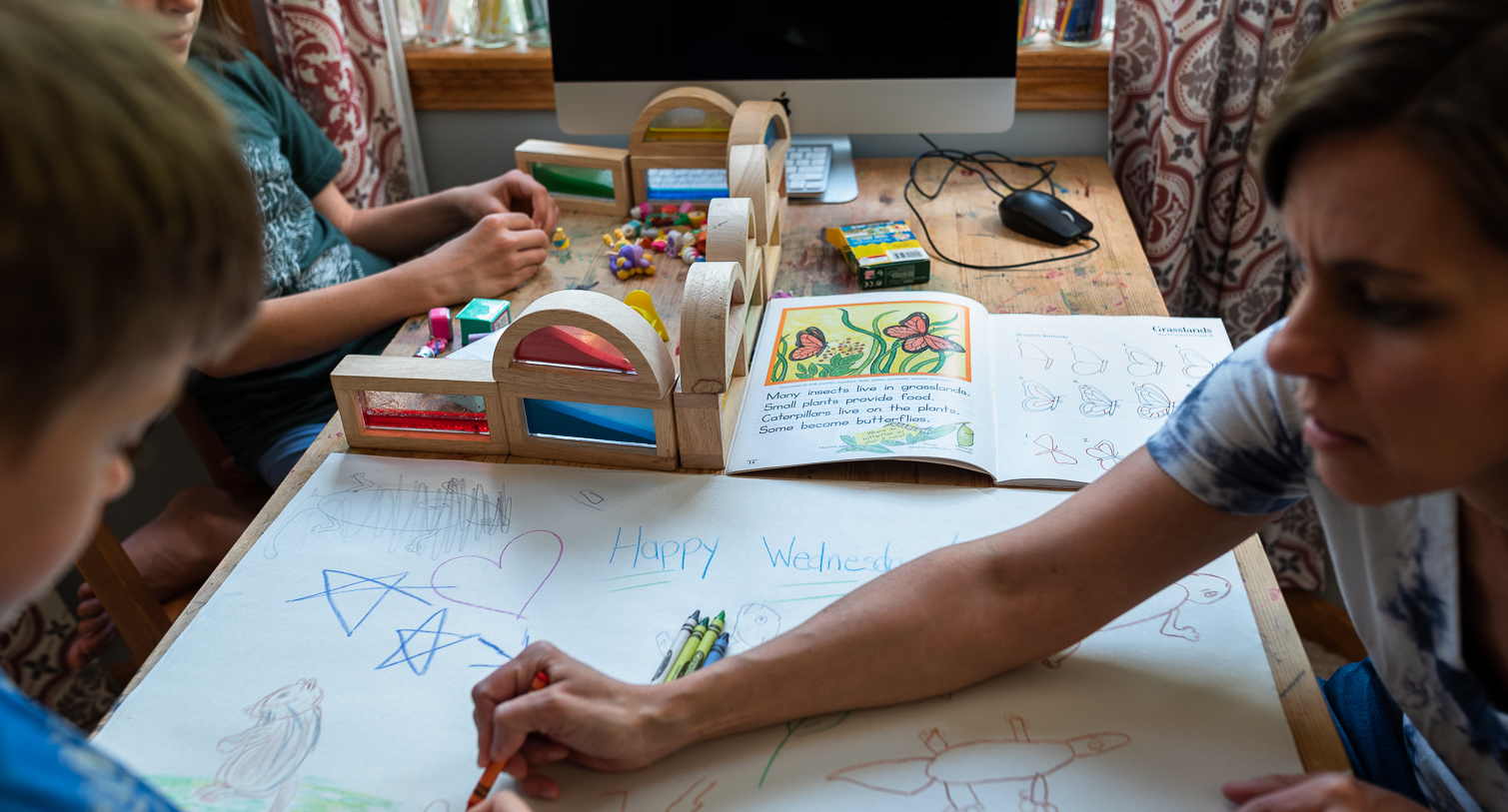Building Strong Writers at Home | Insights from Occupational Therapist Sarah Collins
Parenting multiple children of varying needs and abilities is akin to juggling on a unicycle—both exciting and challenging in equal measure. As a homeschooling parent, I’ve had my share of furrowed brows over a myriad of educational puzzles, not least the puzzle of teaching handwriting.

Is it perplexing to you, too? You’re not alone! Let’s dig into the art and science of helping our children develop this essential skill.
Understanding Handwriting as a Multi-Faceted Task
At first glance, handwriting might seem like a simple task—pencil to paper and go. But, dive a little deeper and you discover it’s more like an iceberg. What’s visible above the water is but a fraction of what’s required beneath the surface. Factors like fine motor skills, core stability, visual motor skills, grip strength, and hand muscle development all interplay in the act of writing.
The Significance of Core and Upper Body Strength
Did you know that writing is a full-body workout for your child’s fine motor muscles? It’s true! Ensuring your kids have a strong core and upper body is paramount for optimal control and precision in handwriting. Fun activities like writing on vertical surfaces or splashing around and drawing during bath time aren’t just play; they’re building blocks for fine motor skills.
Integrating Learning Into Daily Life
While structured learning has its place, it’s vital to weave educational moments into the ordinary. Baking sessions can turn into math lessons, bedtime stories can enhance language skills, and that preposition game during tidy-up time? You got it; it’s grammar disguised as fun! The goal is to be intentional, making the most of these natural opportunities for learning.

Combining Activities for Skill Development
Why not kill two birds with one stone? Activities that develop handwriting can also be used to boost other skills like social abilities. For example, set up a pen pal situation where children write letters to each other or thank-you notes after a birthday party. This combines motor skill practice with learning to appreciate and connect with others.
Technology as an Aid, Not a Crutch
In our tech-savvy world, gadgets can be a lifeline. They can assist with dictation, spell check, and even organization—all pivotal in writing. But be careful! It’s about striking a balance rather than letting technology take over. Encourage your children to use it as a support tool while they develop their handwriting capabilities.
Self-Advocacy and Accommodations
One significant aim in educating children is to enable them to stand up for their needs and wants. This might mean using a special grip on their pencil or requesting a quiet corner away from distractions. These skills are not just about penmanship; they’re life lessons in self-awareness and self-help.
The Magic of Mistakes
Here’s a thought—mistakes are not just acceptable; they’re necessary. Eraser marks are signs of learning, perseverance, and growth. Normalize the editing process for your kids. Show them that it’s okay to backtrack, rethink, and improve. That’s where real progress and confidence are fostered.
Persistence and Building Stamina
Encouraging our children to keep at it, especially through challenges, is a vital teaching task. Whether it is completing a page in a workbook or trying again after a misspelled word, persistence is key. It’s about building not only skill but also the resilience and endurance needed in life beyond the pen and page.
Siblings Influence – A Dual-Edged Sword
If you have multiple children, you know the influence siblings can wield. It’s a balance of learning from each other and replicating behaviors that might not always be ideal. Harness this influence positively—older kids can model good handwriting habits for the littles, turning sibling dynamics into a learning advantage.
Identifying Underlying Issues
Before you jump into a curriculum purchase thinking it will be the panacea for your child’s handwriting challenges, take a minute. Assess the underlying elements that might be hindering their writing abilities. Could there be core muscle weakness? Perhaps the issue is with grip strength or something less concrete, like confidence?

The Detective Work of Parenting
As parents, we play the role of detectives, piecing together clues about our children’s learning experiences. Observe your child, ask questions, and be curious about why they succeed in some areas and struggle in others. You are the expert when it comes to your child; embrace that role wholeheartedly.
Support and Resources at Your Fingertips
Now, for the reassuring part—you’re not alone on this handwritten ship. The homeschooling world is ripe with resources, from blogs and focus groups to videos and, yes, free materials at your fingertips. Before you invest in pricey curriculum options, explore what’s available for free. You might be pleasantly surprised.
Wrapping it all up, the journey of teaching handwriting, like any parenting journey, is filled with highs and lows, triumphs and trials. But amidst all the pencil sharpening and paper-stocking, take a moment to breathe in the joyous chaos of homeschooling life. Remember, your effort and dedication are shaping lifelong learners, writers and thinkers. Happy teaching (and learning)!
RLL#238: Building Strong Writers at Home | Insights from Occupational Therapist Sarah Collins
In the latest episode of the podcast, we chat about a skill that often leaves even the most adept homeschooling parents in search of guidance: handwriting.
Sarah Collins, our favorite occupational therapist with a homeschooling background and a love for nurturing writing skills in children, unpacks the multifaceted journey of handwriting, from the initial scribbles to fluent cursive.
Key Takeaways From This Episode Include:
- Encouraging fine motor skills in everyday play.
- Understanding and leveraging technology to support writing.
- Instilling self-advocacy in your learners.
- The vital role of grip strength and motor control in writing.
- Strategies for boosting endurance without causing burnout.
✍️ Actionable Insights for Your Homeschooling Adventure
The episode is more than a mere dialogue.
It’s a treasure trove of actionable tips and heartwarming humor (don’t miss the part about being “raised by wolves”!).
📚 Resource Roundup
We’ve heard your calls for resources, and Sarah Collins doesn’t disappoint.
From fine motor screeners to grip-strengthening exercises, we provide a rich landscape of free resources and proven curriculums tailored to your individual learner’s needs.
👂 Listen and Learn
Ready to demystify handwriting hurdles?
Tune in to this inspiring session with Sarah Collins.
Our sponsor for today’s episode is CTC Math
Links and Resources from Today’s Show
- Pre-Order – The Homeschool Advantage: A Child-Focused Approach to Raising Lifelong Learners
- Raising Lifelong Learners Membership Community – The Learners Lab
- Raising Resilient Sons by Colleen Kessler, M.Ed.
- Homeschool OT with Sarah Collins
- The OT is IN Podcast
- Join the OT is IN Membership!
- Strengthening Executive Function Skills: A Conversation with Sarah Collins
- Helping Our Kids Self-Regulate with Sarah Collins
- Coping with Stress | Supporting Kids and Teens
- Thriving Together | Creating Supportive Environments in Homeschooling
- Self-Care and Co-Regulation | Balancing Parenting and Sensory Needs
- The OT is IN – Understanding the Role of Vision in Your Child’s Learning Journey
- The OT is IN – Visual Pathways to Learning: Harnessing Nature and Vision in Homeschooling
- The OT is IN – Understanding the Power of Form Drawing: A Parent’s Guide to Waldorf Education
- Handwriting Motor Skill Assessment
Connect with Sarah Collins
Website: Homeschool OT
You can also find Sarah on Instagram @HomeschoolOT
Leave a Rating or Review
Doing so helps me get the word out about the podcast. iTunes bases their search results on positive ratings, so it really does help — and it’s easy!
-
- Click THIS link to go to the podcast main page.
- Click on View in iTunes under the podcast cover artwork.
- Once your iTunes has launched and you are on the podcast page, click on Ratings and Review under the podcast name. There you can leave either or both! Thanks so much.

